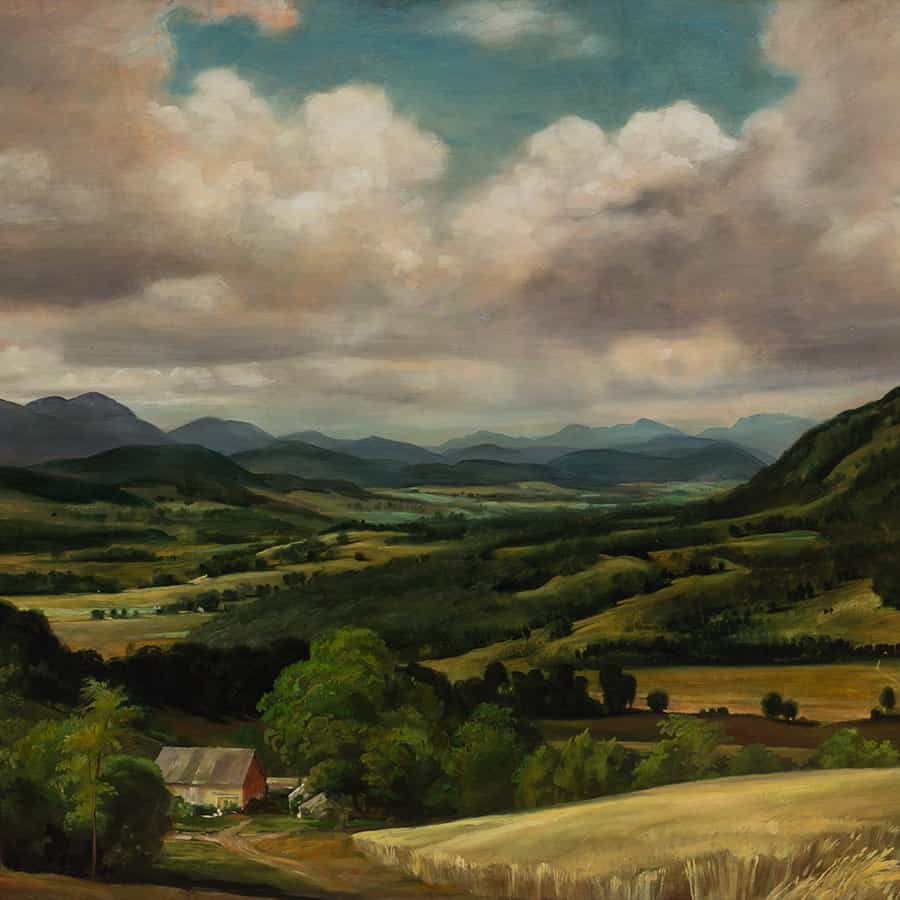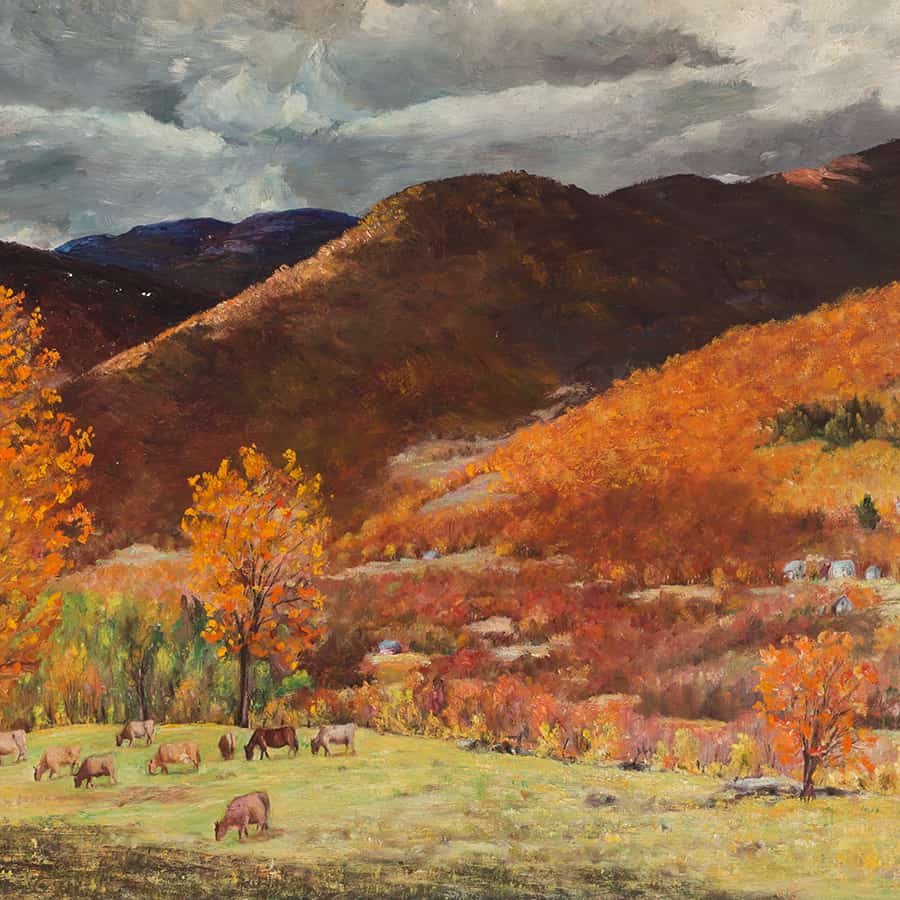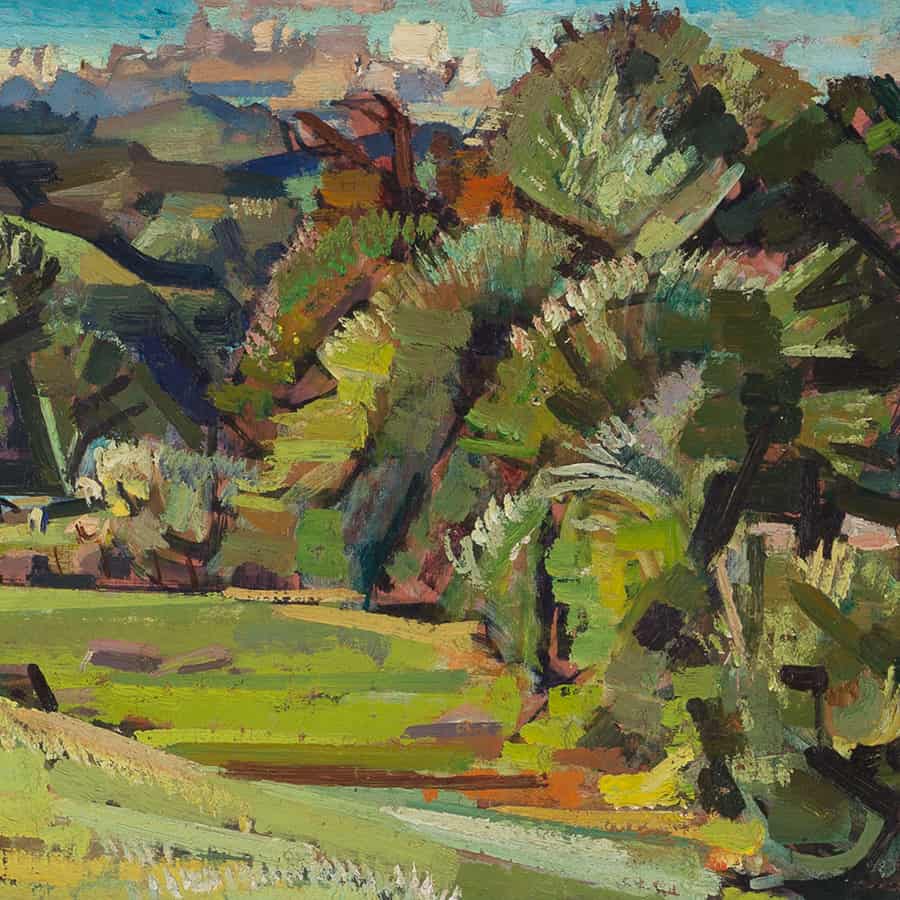Landscapes
In real life and in artwork, Vermont’s mountains are always an interesting middle territory between the lower foreground of a composition and the upper part of the canvas showing blue sky and unpredictable cloud formations. A lot of imagination is often layered onto landscape paintings of every genre; if the subject matter of a distant mountain is not all that thrilling, a painter’s use of color or scale certainly will be. One thing that all artists apply their vivid imaginations to is clouds; few artists paint that blue-with-no-name that is characteristic of many days in Vermont in every season. Painters especially love to capture those moments when rays of first light begin to kiss the mountaintops long before the warmth of the sun seeps into the lowland farms and villages. Likewise, the setting sun offers artists even more interesting lighting effects – dropping the valleys into sudden darkness while the peaks seem to hold onto their glow almost until the stars begin to shine.
Excerpt from the book For the Love of Vermont: The Lyman Orton Collection

Derby View, 1939 (Mettawee Valley)
Oil & Tempera on Canvas | 24 1/8 x 40 in.
William Dean Fausett (1913–1998)
William Dean Fausett often went by Dean. He was a member of the group known informally as the Dorset Painters and later, more formally, as the Southern Vermont Artists. He was a key figure in the acquisition of the Webster estate (Yester House) in 1950, which evolved into the Southern Vermont Arts Center.
Fausett was one of the many artists who divided his time between Vermont and New York. Several important museums across the country have his works in their collections, including the Metropolitan Museum of Art; Whitney Museum of American Art; Smithsonian American Art Museum; Addison Gallery of American Art in Massachusetts; Dorset Historical Society; Bennington Museum; and Southern Vermont Arts Center.
Lyman Orton acquired this painting at auction when it was deaccessioned by New York’s Museum of Modern Art. MOMA bought the painting in 1939 or ‘40 after Fausett exhibited it there. During the Eisenhower administration, it hung at the White House. The view is of the Mettawee Valley, seen from a high point on Derby Road in Rupert.

Autumn in the Hollow, c. 1975 (Dorset)
Oil on Canvas | 30 x 40 in.
Claude Dern (1906-1995)
The Orton Collection includes several landscape paintings by the French-born artist Claude Dern. By all accounts his personality was so genuinely larger than life that no brief remarks can do the man or his artistic career justice. It is a mystery that he found time to paint and exhibit his work as much as he did while being involved in so many other pursuits, including opening a restaurant, becoming famous as the “Dorset Strawberry King” for his berry farming, and his colorful career in politics in the Vermont state legislature, followed by a lively but unsuccessful run for the U.S. Congress.
Born and raised in France, he came to the United States at the suggestion of a local couple who had met him while they were traveling abroad. He studied art in New York City, lived elsewhere at times, but the nucleus of his life was ultimately Dorset. His name first appears as an exhibiting artist in the catalog for a Southern Vermont Artists show in 1940.
The distinctly exuberant style in which Dern painted the scenery of Vermont in every season makes his work fascinating. Exhibiting alongside his contemporaries among the Dorset Painters in the SVA’s annual shows, it is clear that none of them influenced his style.
“The Hollow” referred to in the title is Dorset Hollow. It is a geological feature shaped like a gigantic three-sided bowl, and the near and far views of the mountains that hug the deep valley are usually recognizable in paintings and in old photographs. The two roads in the Hollow are called Upper Hollow and Lower Hollow Road: they hairpin together deep in the back of the bowl. One writer said this about Dorset Hollow: “It feels like a land apart, a fairytale place untouched by the outside world.”

The Orton’s Pasture, Plainfield, Vermont, 1941
Oil on Masonite | 16 ¼ x 36 ¼ in.
Herbert Barnett (1910-1972)
The Orton Farm was a dairy farm in Plainfield, Vermont. Herbert Barnett spent his summers in Plainfield and painted the Orton pasture many times.
Barnett came out of the Boston Museum School of Fine Arts, but he established himself as an artist early in his career. Originally from Providence, Rhode Island, he took night art classes at the famed Rhode Island School of Design while he was still in high school. He studied painting during his summer vacations in Rockport, Massachusetts, with Aldro Hibbard of the Cape Ann School of painters. (Hibbard’s works are also in The Orton Collection.) Barnett’s first one-man show was at a gallery in Boston – he was 18 years old at the time. On a three-year fellowship in the early 1930s, he traveled and studied art in Europe.
In 1940, he was the director of the Worcester Art Museum and summered in Vermont. A decade or so later, he became the dean of the Art Academy of Cincinnati, the school of the Cincinnati Art Museum, a position he held until his death. Many American museums and institutions have collected Barnett’s work.
